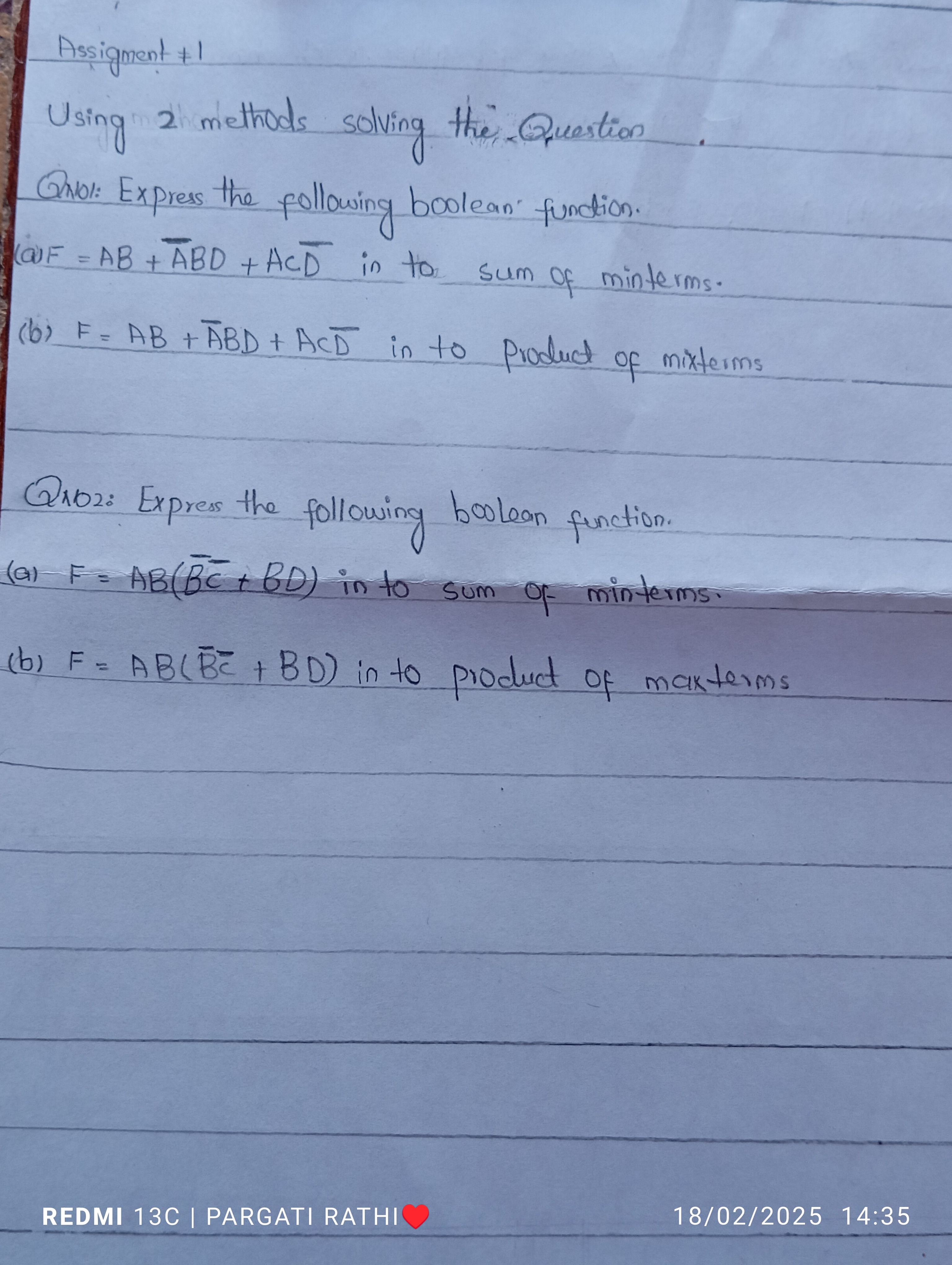1. Express the following boolean function in the sum of minterms: (a) F = AB + ĀBD + AC̄D (b) F = AB + ĀBD + AC̄D in to product of maxterms 2. Express the following boolean functio... 1. Express the following boolean function in the sum of minterms: (a) F = AB + ĀBD + AC̄D (b) F = AB + ĀBD + AC̄D in to product of maxterms 2. Express the following boolean function: (a) F = AB(B̄C + BD) in to sum of minterms (b) F = AB(B̄C + BD) in to product of maxterms

Understand the Problem
The question involves simplifying and expressing boolean functions in different canonical forms. Specifically, it involves converting Boolean expressions into Sum of Minterms (SOP) and Product of Maxterms (POS) forms. This requires understanding Boolean algebra, minterms, maxterms, and how to manipulate logical expressions to fit the required formats.
Answer
Q1: (a) $F = \sum m(5, 7, 9, 12, 13, 14, 15)$ (b) $F = \prod M(0, 1, 2, 3, 4, 6, 8, 10, 11)$ Q2: (a) $F = \sum m(13, 15)$ (b) $F = \prod M(0, 1, 2, 3, 4, 5, 6, 7, 8, 9, 10, 11, 12, 14)$
Answer for screen readers
Q1: (a) $F = \sum m(5, 7, 9, 12, 13, 14, 15)$ (b) $F = \prod M(0, 1, 2, 3, 4, 6, 8, 10, 11)$
Q2: (a) $F = \sum m(13, 15)$ (b) $F = \prod M(0, 1, 2, 3, 4, 5, 6, 7, 8, 9, 10, 11, 12, 14)$
Steps to Solve
Q1 (a): F = AB + ĀBD + AC̄D to Sum of Minterms
- Expand each term to include all variables (A, B, C, D) To convert to minterms, each term must contain all variables. We'll use the identity $X = X(Y + \bar{Y})$ to achieve this.
$AB = AB(C + \bar{C})(D + \bar{D}) = AB(CD + C\bar{D} + \bar{C}D + \bar{C}\bar{D}) = ABCD + ABC\bar{D} + AB\bar{C}D + AB\bar{C}\bar{D}$
$\bar{A}BD = \bar{A}BD(C + \bar{C}) = \bar{A}BDC + \bar{A}BD\bar{C} = \bar{A}BC D + \bar{A}B\bar{C}D$
$A\bar{C}D = A\bar{C}D(B + \bar{B}) = A\bar{C}DB + A\bar{C}D\bar{B} = AB\bar{C}D + A\bar{B}\bar{C}D$
-
Write out all terms $F = ABCD + ABC\bar{D} + AB\bar{C}D + AB\bar{C}\bar{D} + \bar{A}BCD + \bar{A}B\bar{C}D + AB\bar{C}D + A\bar{B}\bar{C}D$
-
Remove duplicate terms Notice that $AB\bar{C}D$ appears twice.
$F = ABCD + ABC\bar{D} + AB\bar{C}D + AB\bar{C}\bar{D} + \bar{A}BCD + \bar{A}B\bar{C}D + A\bar{B}\bar{C}D$
- Convert to minterm notation Convert each term to its minterm equivalent. Recall that $A=1, \bar{A}=0$. We have 4 variables, so our minterms will range from $m_0$ to $m_{15}$.
$ABCD = m_{15}$ (1111) $ABC\bar{D} = m_{14}$ (1110) $AB\bar{C}D = m_{13}$ (1101) $AB\bar{C}\bar{D} = m_{12}$ (1100) $\bar{A}BCD = m_{7}$ (0111) $\bar{A}B\bar{C}D = m_{5}$ (0101) $A\bar{B}\bar{C}D = m_{9}$ (1001)
- Write the sum of minterms $F = m_{15} + m_{14} + m_{13} + m_{12} + m_{7} + m_{5} + m_{9}$
$F = \sum m(5, 7, 9, 12, 13, 14, 15)$
Q1 (b): F = AB + ĀBD + AC̄D to Product of Maxterms
- Find the minterms that are NOT in the SOP expression We have minterms from 0 to 15. The SOP form includes minterms 5, 7, 9, 12, 13, 14, and 15.
The missing minterms are: 0, 1, 2, 3, 4, 6, 8, 10, 11.
- Write the maxterm expression $F = \prod M(0, 1, 2, 3, 4, 6, 8, 10, 11)$
Q2 (a): F = AB(B̄C + BD) to Sum of Minterms
- Simplify the expression
$F = AB(\bar{B}C + BD) = AB\bar{B}C + ABBD = 0 + ABD = ABD$ (Since $B\bar{B} = 0$ and $BB = B$)
- Expand the term to include all variables (A, B, C, D)
$ABD = ABD(C + \bar{C}) = ABCD + AB\bar{C}D$
- Convert to minterm notation
$ABCD = m_{15}$ (1111) $AB\bar{C}D = m_{13}$ (1101)
- Write the sum of minterms
$F = m_{15} + m_{13}$
$F = \sum m(13, 15)$
Q2 (b): F = AB(B̄C + BD) to Product of Maxterms
- Find the minterms that are NOT in the SOP expression The SOP form includes minterms 13, 15.
The missing minterms are: 0, 1, 2, 3, 4, 5, 6, 7, 8, 9, 10, 11, 12, 14.
- Write the maxterm expression
$F = \prod M(0, 1, 2, 3, 4, 5, 6, 7, 8, 9, 10, 11, 12, 14)$
Q1: (a) $F = \sum m(5, 7, 9, 12, 13, 14, 15)$ (b) $F = \prod M(0, 1, 2, 3, 4, 6, 8, 10, 11)$
Q2: (a) $F = \sum m(13, 15)$ (b) $F = \prod M(0, 1, 2, 3, 4, 5, 6, 7, 8, 9, 10, 11, 12, 14)$
More Information
Sum of minterms (SOP) expresses the function as a sum (OR) of minterms, where each minterm is a product (AND) of the variables, either complemented or uncomplemented.
Product of maxterms (POS) expresses the function as a product (AND) of maxterms, where each maxterm is a sum (OR) of the variables, either complemented or uncomplemented.
Tips
A common mistake is to forget to include all variables in each term when expanding to minterms or maxterms. Another mistake could be not removing duplicate terms or incorrectly converting between binary representation and minterm/maxterm indices.
AI-generated content may contain errors. Please verify critical information